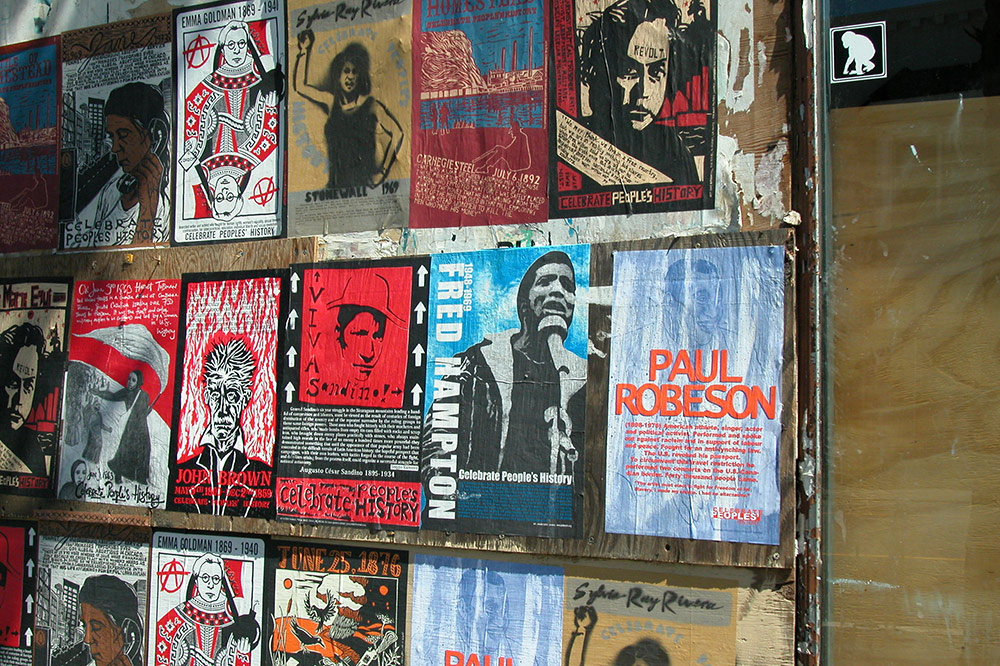Josh MacPhee
Almost ten years ago I wrote an essay entitled “Four Questions for Anarchist Art,” which was published in Perspectives on Anarchist Theory. My intention here was to do some basic updating and republish that essay largely as is. But ten years is a long time, and much has changed, both in the world and in how I think and what I think about. The original four questions of the title were straightforward prompts to encourage people to think through the different ways intentionally political art functions and is interpreted: Is the art anarchist in content? In form? In the means of its production? And finally, does it contest state or corporate power—does it attempt to challenge capitalist social relations?
From my vantage point today, the last question seems the only one dynamic enough to be worth asking. Ushered in by disillusionment with the perceived cultural excesses of the 1960s and the emergence of art as a hyper-commodity in the 1980s and ’90s, much of the American Left has rejected culture as a primary terrain of struggle. Antiauthoritarians are the ones who have largely spurned this neo-philistinism: They have been extremely successful in using art and spectacle in the past fifteen years in the U.S. and elsewhere, whether to re-energize the protest movement in Seattle with both puppets and window smashing or to perform direct democratic politics in the street for all to see (and participate in) during the Occupy movement.
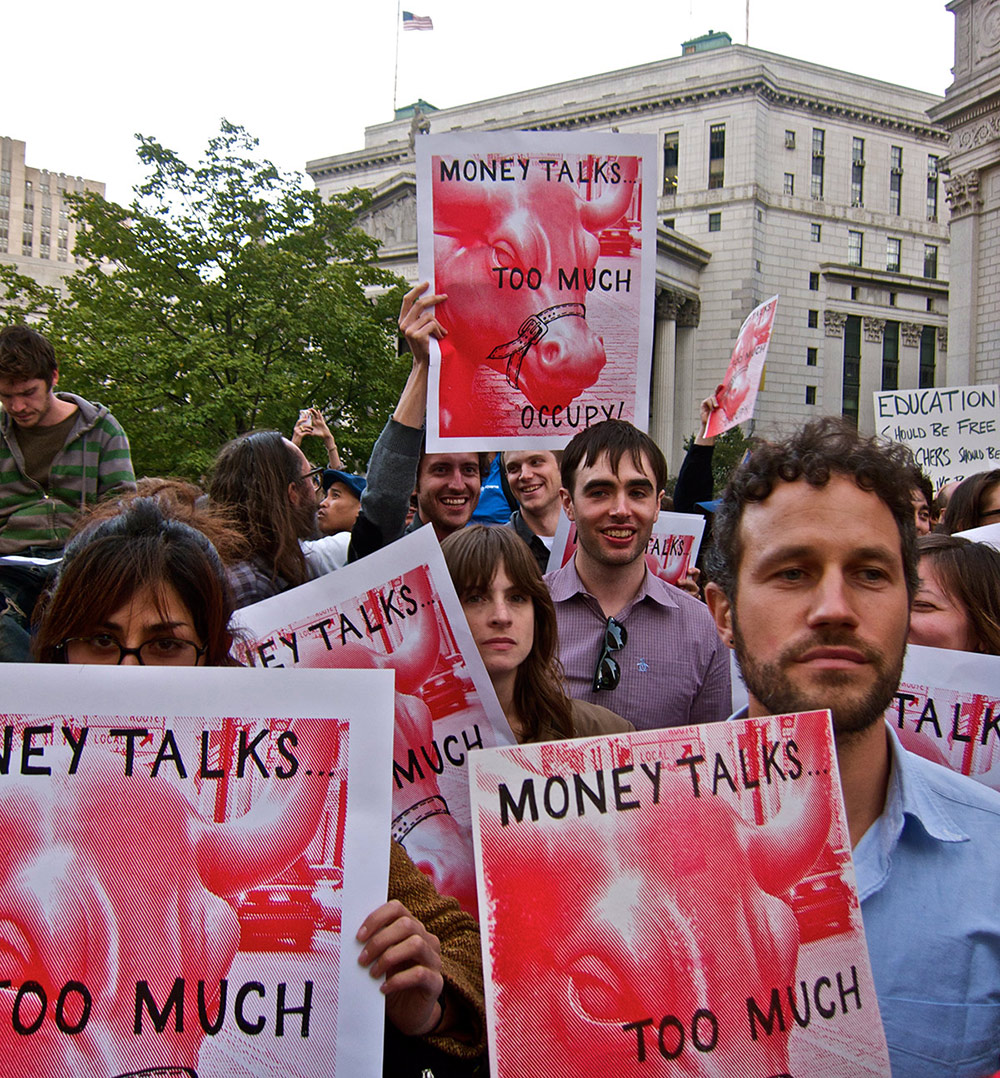
Josh MacPhee’s poster Money Talks . . . Too Much in use at an Occupy demonstration in New York City, 2011. Photograph by Jeremy Ayers.
Yet much of this activity appears disconnected from the past. Many participants feel little connection to earlier movements, even if they unwittingly borrow tactics from them. This is regrettable, as historically art has played an important role in revolutionary social movements. We inherit a long tradition of cultural resistance, particularly in the graphic arts. While this history feels thin—and often hidden—in the U.S. context, if we look a bit further away, examples abound. The graphics collectives of the Ateliers Populaire played an integral role in the student-worker uprising in Paris in May 1968. Amilcar Cabral has written extensively on the central role of culture in the African liberation movements in the ’60s and ’70s. Posters, street art, political T-shirts, and songs were integral to the movements that coalesced and overthrew Apartheid in South Africa in the 1980s and ’90s. While these are not explicitly anarchist instances (although antiauthoritarianism influenced both French and many African struggles), anarchism has always drawn from a wide and diverse array of moments and contexts.
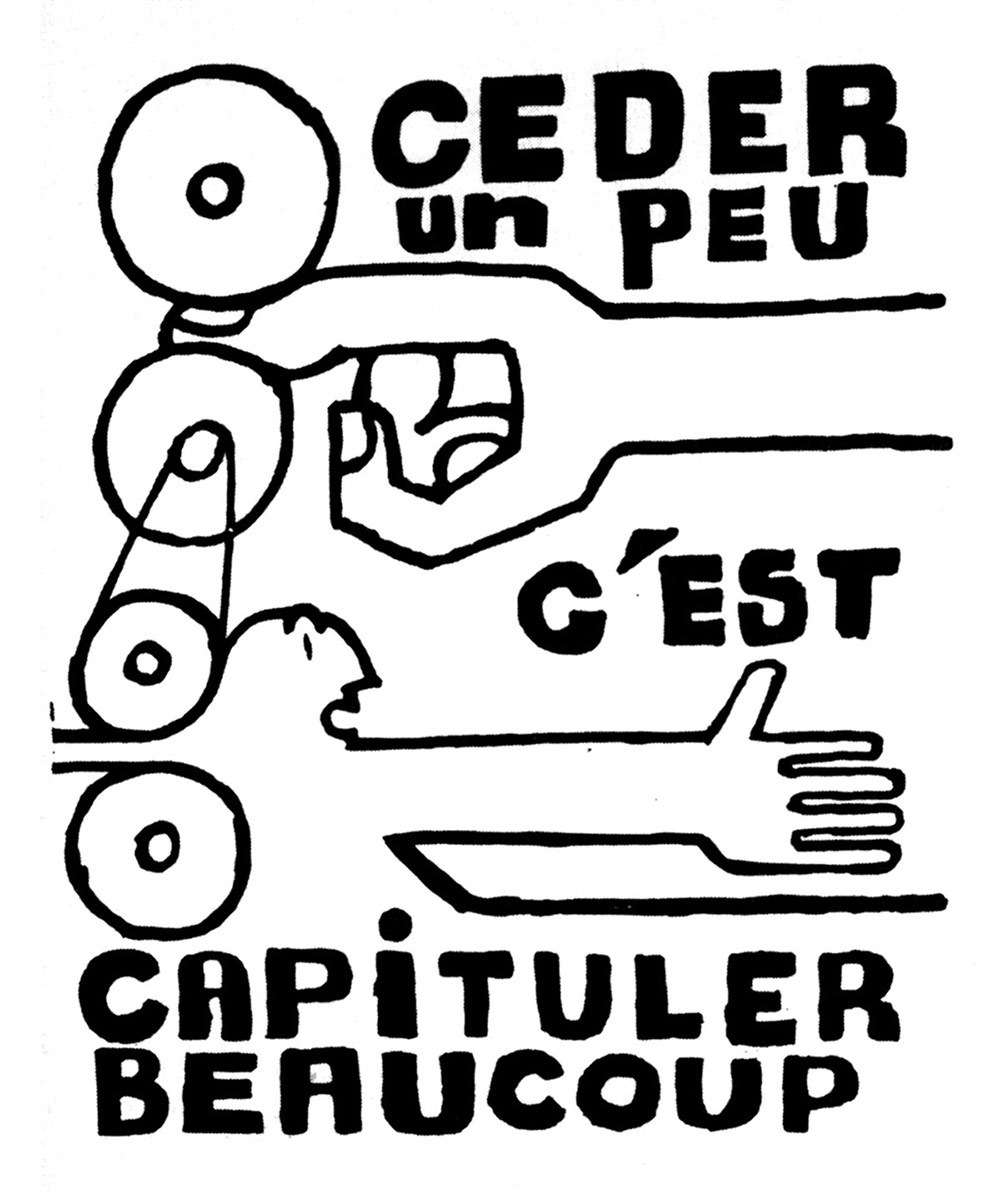
Atelier Populaire, Céder un peu c’est capituler beaucoup (To Give a Little Is to Capitulate a Lot), screen print poster, France, 1968.
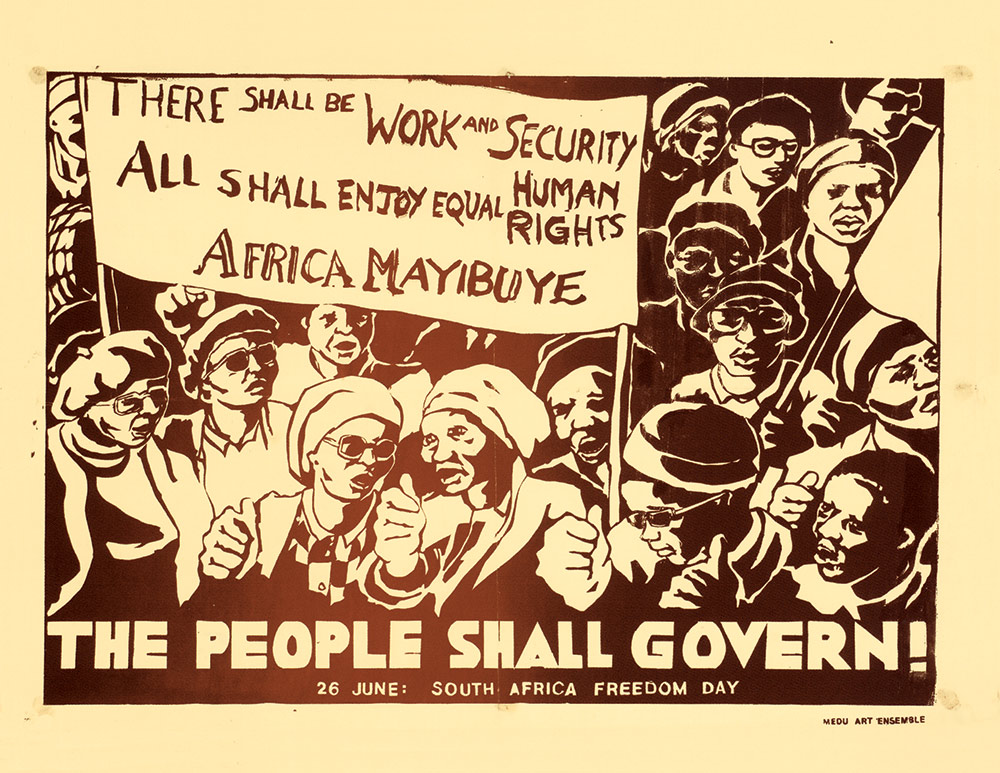
Medu Art Ensemble (designer: Judy Seidman), The People Shall Govern, screen print poster, Botswana/South Africa, 1982.
Even while resistance culture has been integral to movements, much of its history—our history—seems lost to contemporary protestors. We are far more likely to have a corporation create advertisements through mining our own visual archive than to study and understand this history ourselves. While central to our practice, the art of culture, media, and design is rarely the focus of debate for anarchists and antiauthoritarians. We actually find ourselves in a bit of a paradox: Art simultaneously feels marginal, yet it affects larger parts of our lives. As art has become increasingly rarefied in our society and relegated to museums, expensive galleries, and the private collections of the economic elite, the rest of us tend to spend decreasing amounts of time thinking about it. At this same moment, corporations and the state heavily lean on design, culture, and other forms of soft power to convince all of us that we are better off with the impoverishment we have than fighting for something more.
Under these circumstances, it is easy for artists and designers to believe we are increasingly central to the functioning of society. As we become disillusioned with our lack of access to power in other aspects of life, forums like the New York Times and Artforum overstate both the power of culture and our power as participants in it. Artists and “social” designers are increasingly presented by elements within the state, the media, and the corporate world as a panacea, our creativity replacing infrastructure, investment, and control over one’s life as the mechanism for solving social ills—from homelessness to AIDS to natural disaster relief. Design and designers (in print, web programming, and spatial design), as the arbiters of what most of our world looks like, have been inflated as essential cogs in the mechanisms of capitalism. It is important for those trying to challenge capital not to allow these assumptions to go unchecked.
Art, because of its very ability to tap into the qualitative, to reach into the realms of emotion and complex human relationships, often raises impossible expectations—but it can’t do anything alone. I believe that large-scale social movements, comprised of tens of thousands of people from a diversity of demographics and skill-sets, can still threaten the status quo of state and corporate power. We must not be confused by the spectacles we ourselves create: While representations of, and gestures towards, these movements have power, they are no substitute for the things themselves. Art can, and must, be a part of these movements. It can motivate through song, inspire through narrative, educate through graphic illustration, but it is not a movement in and of itself. Cultural production must work in concert with all the other terrains of social struggle; it will never yank down the statue of the status quo alone.
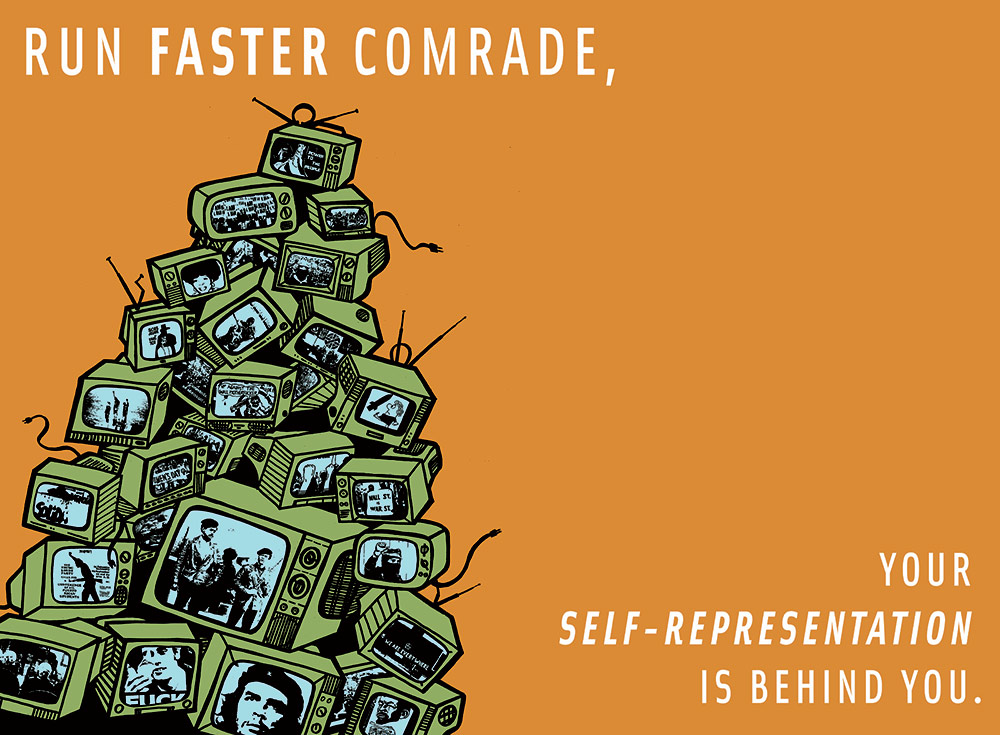
Josh MacPhee, Run Faster Comrade, Your Self-Representation Is Behind You, poster design, 2008. This title is a contemporary reworking of the Paris 1968 Situationist-inspired slogan, “Run, comrade, the old world is behind you.”
This contradiction, that the art we make feels increasingly marginal while at the same time more of our world is designed and crafted by artists and cultural producers, demands nuanced and dynamic thinking amongst antiauthoritarians. Yet our definition of “Anarchist Art” is usually by default simply art created by an anarchist, whether a clip-art graphic, a heavy metal song, agit-prop street theater, or an abstract painting. Identity becomes the arbiter of political ideals, and in this context anarchism becomes little more than one of dozens of ideological outfits available in the capitalist strip mall of political fashion. Rather than being content with shallow or unconsidered perspectives on art, anarchists must develop our ideas about how art and culture operate in society, influence emotions and ideas, and activate movements for social change.
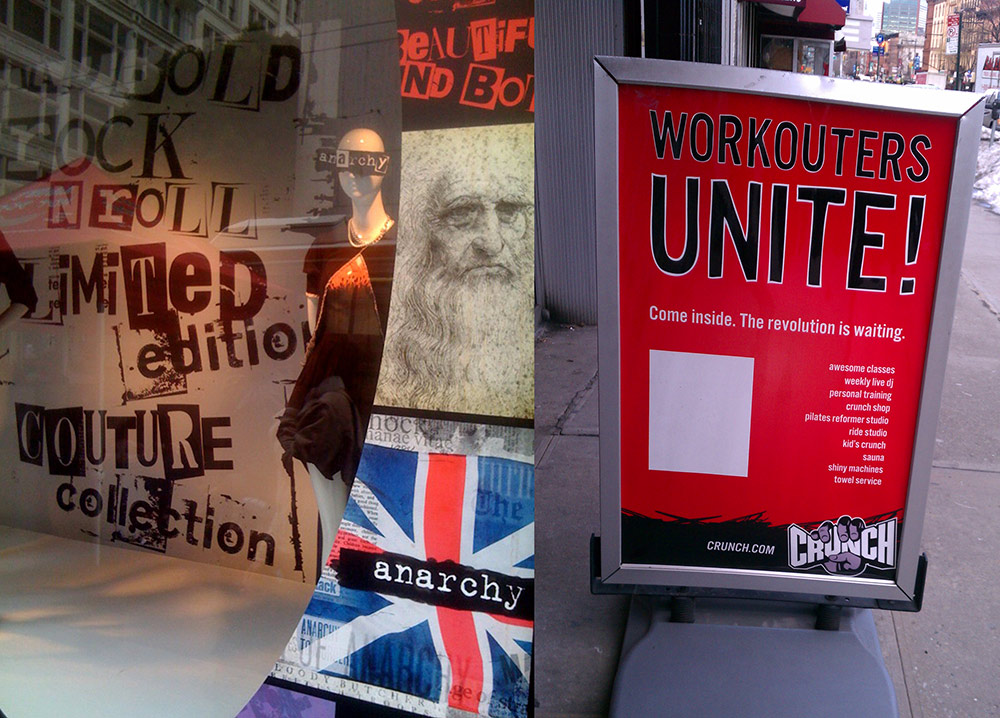
An anarchy-themed shop window in New York City, 2011 and a “revolutionary” workout offer, Brooklyn, New York, 2011.
For almost twenty years I have been producing art and graphics for movement projects and publications, attempting to develop antiauthoritarian concepts and ethics in my practice, and disseminating ideas through art created for and in non-traditional art spaces. Like any other anarchist agitator, I want to debate the effectiveness of my actions, but as a movement we don’t have the proper tools to assess cultural work. (Generally speaking, I have received little critical response to my artwork from other anarchists.) Developing such conceptual and evaluative tools is as complicated as it is vital, since culture and art are qualitative, not quantitative domains. You can count the bodies that came to a protest or the amount of money raised by a fundraiser, but there is no clear scale by which to measure the effectiveness of a cultural product or event. Culture is often more affective than effective, leading to subtle changes in people’s perspectives or decisions rather than sea changes in policy, movement strategy, or society writ large.
So what would a new and more nuanced perspective on “Anarchist Art” look like? If it isn’t just art made by anarchists, what is it? This brings us back to the question, “Does it challenge statecraft and/or capitalist social relations?” I don’t want to create art that makes people think like me (or the political party of which I am a member). But I do want to make art that encourages people to think. It is a collective failure to grapple with complexity and develop critical thinking skills that has undermined so many past movements for social change.
Over time I have attempted to develop artwork that asks questions rather than answers them, or possibly does both. Starting in the late 1990s and early 2000s, I attempted to create graphic art that operates in radical ways but that isn’t simply surface level anarchist propaganda. I designed a series of leaf images, which I stenciled in various shapes and sizes around Chicago. Most were larger-than-life 2’x3’ leaves. Though the content was important, what gave this project resonance was its novelty and context. No one expected to see gigantic leaves painted in front of their apartments. They weren’t traditional graffiti, though they were spray painted, which clearly made them illegal (in draconian turn-of-the-century Chicago). They weren’t murals, and they didn’t operate in the way most community art projects do. They weren’t advertisements, and they weren’t communicating a clear or simple message. All of this forced an audience to ponder this alien invasion in the visual landscape. Since there is so little in public view that asks that we think, this demand that we look and think is more political than it might first appear. Although not originally intended as such, the leaves became an environmental statement: By haunting the cityscape with the promise of flora, they raised simple questions about why the primary green spaces in the city are ostentatious, corporate-sponsored tourist zones like Millennium Park rather than the city streets and areas frequented by working class Chicagoans.
Form and context are important to consider when looking at art’s potential to transform an audience’s consciousness or outlook. In the abstract, an image of a leaf is hardly radical, or even political. It is the how, why, and where of the leaf that is important. In this example, effectiveness demanded that I consciously reject anarchist content in order to catch the viewer off guard. In addition, because the work is situated on the street, it is free and at least theoretically accessible to everyone (the realpolitik of urban space makes this a complicated claim, but that’s for another essay); ironically, this location also makes the art illegal. Its very existence is evidence that someone transgressed the boundaries of societally acceptable ways to communicate. Ideally, this should raise provocative questions for the viewer about the nature of control, communication, and public space—and I believe it did in this case. But historical moment is also a factor here, and I doubt such a project would be as effective today. Since I painted the leaves, street art has become one of the main visual placeholders for development, gentrification, and a commercialization of space. It no longer reads as a threat to these things, but their very hallmark.
Like the larger anarchist movement, which creates and re-creates inventive ways to collaborate, build, and organize, anarchist artists need to recognize that our efforts are minimized when we work alone. My collaborative work has been far more important than what I’ve done as an individual artist. This collaboration has taken many forms. One example is the Celebrate People’s History poster series, for which I’ve organized almost one hundred artists (so far) to create posters celebrating events, groups, and individuals who have shaped struggles for social justice but generally been erased or sidelined by mainstream history. The posters are mass produced—at a worker-owned printshop—and distributed as widely as possible, wheat-pasted on the street, installed in classrooms, exhibited in art and community spaces, and used as decoration in apartments, homes, and dorm rooms. The politics of the posters are diverse, perhaps even incoherent, as historical figures with deep ideological differences share space in the project. But the more important aspect for me is that these posters create a venue for large numbers of people to identify and take ownership over their own history. The field of knowledge is democratized, as diverse artists design posters, become amateur historians, and stake a claim both as limners of the past and as architects of the future.
How the labor of artists and designers is mobilized in society is largely dependent on how it is used to maintain the status quo. This coercion happens in direct ways in the machinations of the commercial art market or advertising industry. It also unfolds more indirectly and against our will, as when our anarchist graffiti becomes a marker for a “changing neighborhood” ready for development, or when our ways of living and working in the margins of the mainstream economy—and our entrepreneurial ingenuity—are used as models to impose neoliberal austerity on other communities. We can no longer simply throw up a picture of Emma Goldman and call it Anarchist Art. It is imperative that artists, anarchists, and anarchist artists attempt to clarify the ways culture is used to control and oppress us, and articulate new models for art to open up potentials for liberation. Only then can art contest the oppressive conditions and institutions of our lives.

